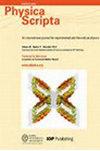具有社会和非线性相互作用的蜂群系统的定向切换行为
IF 2.6
3区 物理与天体物理
Q2 PHYSICS, MULTIDISCIPLINARY
引用次数: 0
摘要
许多移动生物群落的成员之间可能会发生协调的方向转换。一些研究表明,自走粒子模型可以很好地描述定向切换行为。理解群体运动的关键是确定与定向切换行为相关的影响因素。本文重点研究社会和非线性相互作用对蜂群系统中观察到的定向切换行为的影响。其中,非线性相互作用表示为其邻居的速度和速度方向之间的权衡函数。基于降维理论框架,将高维复杂模型简化为一维简单模型,并通过对一维模型的理论分析得到静态概率密度和平均切换时间。可以看出,社会和非线性相互作用在调节蜂群系统的方向切换行为中发挥了重要作用。具体来说,群体密度和非线性参数的增加会抑制方向性切换。对于埃尔德斯-雷尼(Erdös-Rényi)网络,大的平均度可以抑制定向切换行为。对于无标度网络,增加度异质性可以减少平均切换时间。研究结果揭示了社会和非线性相互作用影响蜂群系统定向切换行为的内在机制,为设计具有特定功能的生物启发装置提供了理论基础。本文章由计算机程序翻译,如有差异,请以英文原文为准。
Directional switching behavior of swarming systems with social and nonlinear interactions
Coordinated directional switching can occur among members of many mobile biological communities. Some studies show that self-propelled particle models can describe the directional switching behavior well. The key to understanding group movement is to determine the influential factors relevant to directional switching behavior. This paper focuses on the impact of social and nonlinear interactions on the directional switching behavior observed in swarming systems. In which, the nonlinear interaction is represented as a function of a trade-off between the velocity and velocity direction of its neighbors. Based on the framework of dimension reduction theory, the high-dimensional complex model is simplified into a one-dimensional simple model, and the stationary probability density and mean switching time are obtained by theoretical analysis of the one-dimensional model. It can be seen that social and nonlinear interactions play an important role in regulating the directional switching behaviors of swarming systems. Specifically, the increase of group density and nonlinear parameter can inhibit the directional switches. For Erdös-Rényi networks, the large mean degree can suppress the directional switching behavior. For scale-free networks, increasing the degree heterogeneity can reduce the mean switching time. The results reveal the underlying mechanisms by which social and nonlinear interactions influence the directional switching behaviors of swarming systems, and provide a theoretical foundation for the design of bio-inspired devices with specific functions.
求助全文
通过发布文献求助,成功后即可免费获取论文全文。
去求助
来源期刊

Physica Scripta
物理-物理:综合
CiteScore
3.70
自引率
3.40%
发文量
782
审稿时长
4.5 months
期刊介绍:
Physica Scripta is an international journal for original research in any branch of experimental and theoretical physics. Articles will be considered in any of the following topics, and interdisciplinary topics involving physics are also welcomed:
-Atomic, molecular and optical physics-
Plasma physics-
Condensed matter physics-
Mathematical physics-
Astrophysics-
High energy physics-
Nuclear physics-
Nonlinear physics.
The journal aims to increase the visibility and accessibility of research to the wider physical sciences community. Articles on topics of broad interest are encouraged and submissions in more specialist fields should endeavour to include reference to the wider context of their research in the introduction.
 求助内容:
求助内容: 应助结果提醒方式:
应助结果提醒方式:


